Wandsdyke Wonders
- gladysperrier
- Jul 26
- 10 min read
Updated: Jul 27
It has been too long since I visited my favourite county in England, the wild and beautiful Wiltshire. So it was that my trusted adventurer, Michala, and I drove west leaving Berkshire behind and took ourselves off to one of my favourite locations, Pewsey Down Nature Reserve.

Who’d Have Thought It
As we drove through the pretty village of Lockeridge, past hollyhocks, thatched roofs and ancient sarsen stones, who’d have thought it would have such a peculiarly named inn. However, pie and mash were far from our minds. We had our traditional shortbread fingers to give us that boost of energy for the start of what would prove to be an epic journey.
Parked up at Pewsey Down Car Park, boots laced up, fuelled by our chunky treat and we were ready to go. Turning our backs on Knap Hill we crossed over the road and followed the grassy path heading up the appropriately named Walkers Hill.

Moo-ving Matters
Barely 5 minutes into our walk we were faced with a dilemma. Right up against the ramblers’ gate was a herd of cows. I felt a little uncertain as, some years ago, my brother Clyde and I were walking nearby on Fifield Down, and spotted a bull in our pathway up ahead. We had to find a circuitous route around to avoid an unpleasant incident.
However, today I was wearing my big girl pants and thankfully they were not red. I took a deep breath and decided it was going to be fine. There was a mix of bullocks and cows but no immediate sign of a bull in this large herd. Arriving at the kissing gate I opened it and, even though we were literally face to face, human to bovine, I said ‘yah yah yah! Remarkably, they understood and backed away just enough to allow us through.
Fairly confident we even allowed a moment to photograph these handsome beasts before continuing. Then, walking at a faster pace than we might normally start out, particularly up a hill, we looked left and right as the herd parted, swishing tails as they flicked off flies.

Neolithic Legends
Leaving the group behind us, from the top of Walkers Hill, we were able to stand back and fully appreciate the view of the neolithic long barrow that is Adam’s Grave, respecting this long barrow’s historical significance as a sarsen burial chamber.

Far below us the landscape looked like a patch work of carpets unfurled for display from the soft, relaxing greens to warm golds and oatmeal with flecks of cream. Whilst the terracettes looked like a knitted jumper riddled with dropped stiches.
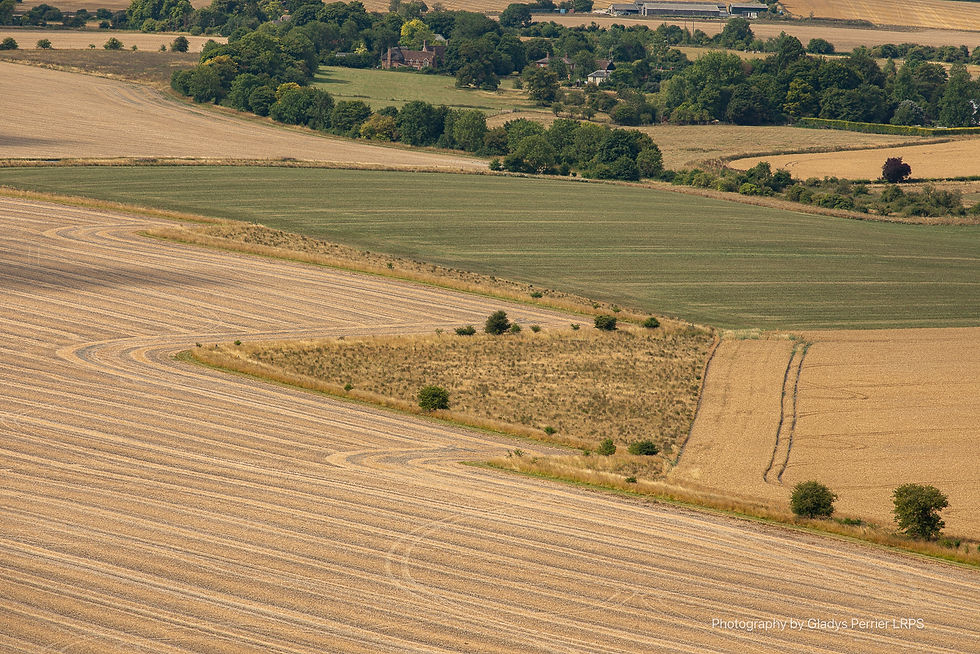
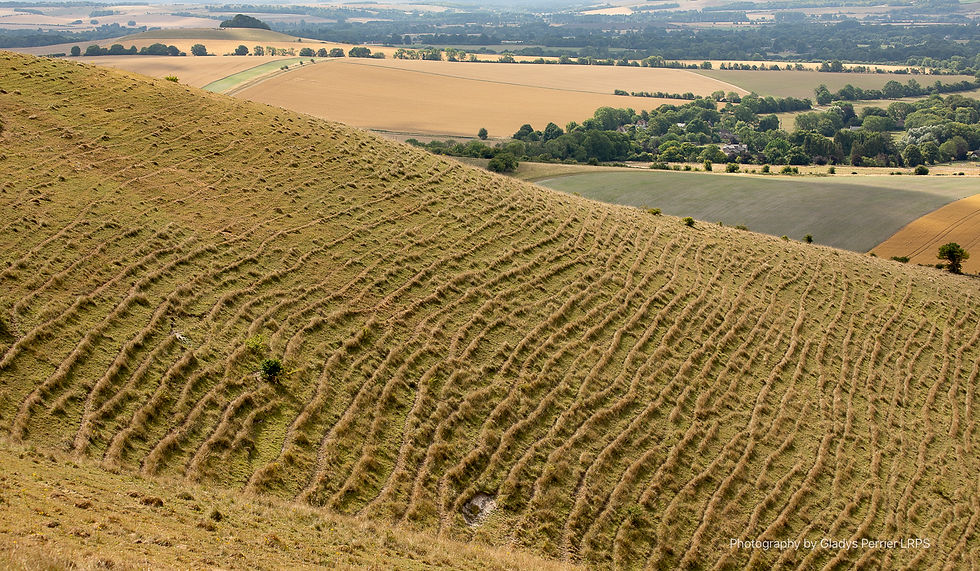
Endowed with a Bounty of Wildflowers
We continued to climb, stopping every so often to admire the scabious, knapweed, clover and harebells all low to the ground like Alpine flowers fighting to survive extreme weather conditions. When I was last here the wind, unlike this day, had been bitter. It made me wonder if perhaps the weather on this side of the sloping hills can be extreme. As we continued further along the sloping hillside we would find those same species looking taller and stronger.
The White Horse Trail
Also looking tall and strong was the Alton Barnes White Horse. He looked pristine as if recently groomed not like the overgrown mess he was in 2022 when I first explored the area.
It cannot be said that we galloped on as every step of the way we delighted in the wildflowers at our feet and the views of the vale below. We were making slow progress awe struck by the vast views and open spaces below in this area which is part of the White Horse Trail. Who would have thought it, but the day would only continued to get better and better.
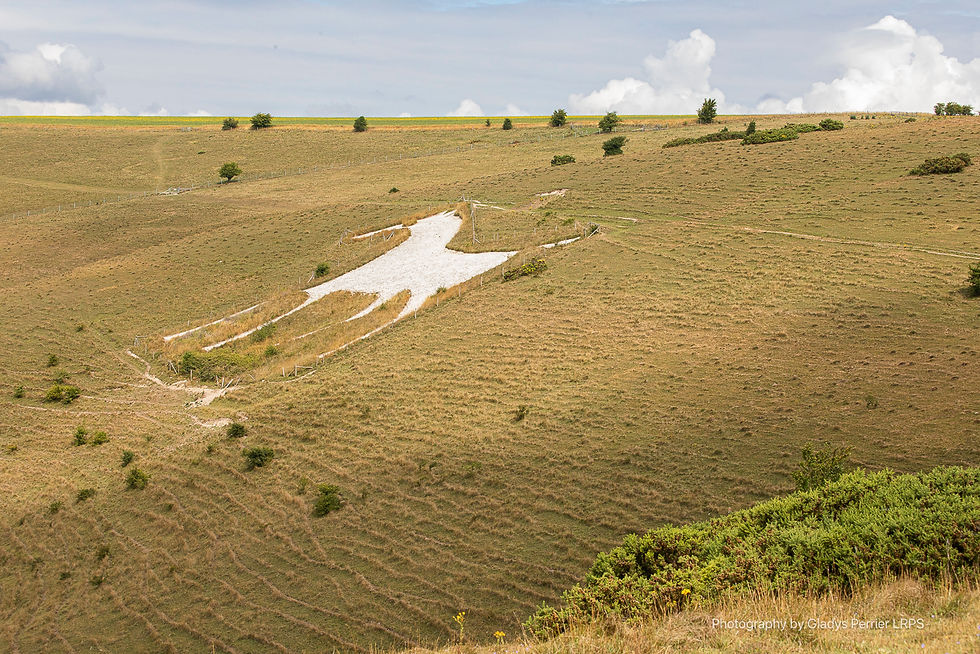
Charming Views
Charms of goldfinches twittered amongst themselves taking flight and moving on, keeping their distance every time we approached them. We walked into a warm westerly breeze admiring the views of the Lansdowne Monument miles ahead.
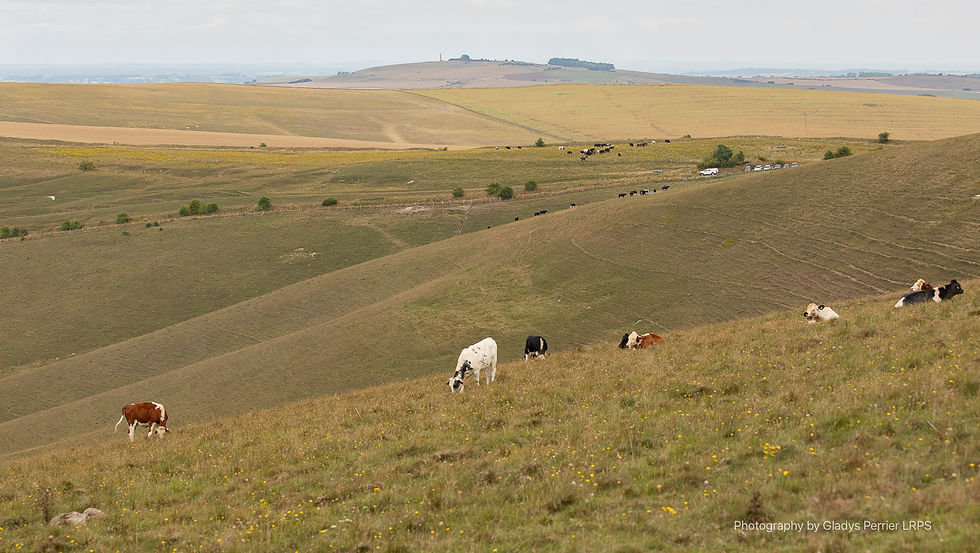
By contrast, closer by stood a more natural column. Standing tall as if on a decorative pedestal with twisting foliage, leading up to its globes of purple florets, was woolly thistle with a Fibonacci spiral of spines. A truly spectacular arrangement.

The Wonderful Wandsdyke
We followed the grassy path over Pewsey Downs National Nature Reserve, along the crest of Milk Hill and we found ourselves in awe as we looked down at the spectacular view of the Wandsdyke as it stretched out to the west, sweeping around as far as the eye could see. A wonderous sight indeed.

In places our path took us to the side of the ditch as it was thick with vegetation, providing much habitat for wildlife. Most of the way the chalky path led us on the ridge of the mound. The route was dotted with hawthorn bushes where we did wonder, had we visited in April might we have found a colony of snails aestivating in the crevices of a hawthorn in the way we found one such wonder during our first day along the Ridgeway National Trail.
We walked at snail’s pace passing a plethora of snails perhaps now waking from dormancy.

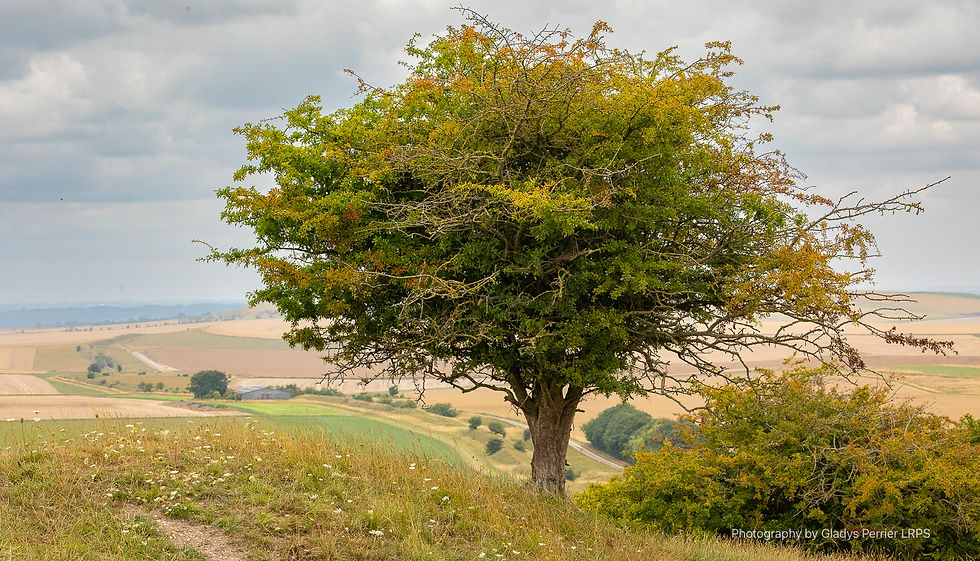
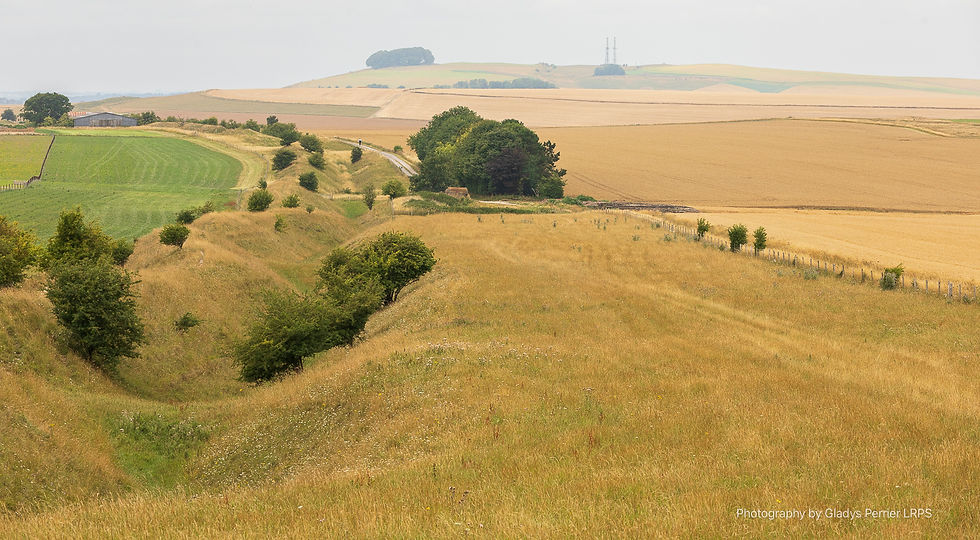
A Wildflower Highway
There are many theories about these linear earthworks. Unsolved debates about when these defences were built and by whom however, on this day we can only say that the entire Woden’s Dyke was invaded by a beautiful display of wildflowers and butterflies. We could barely walk two paces only to stop yet again to admire the now the tall scabious flowers trembling in the balmy breeze unlike the short stems back on Walkers Hill where they huddled low to the ground.
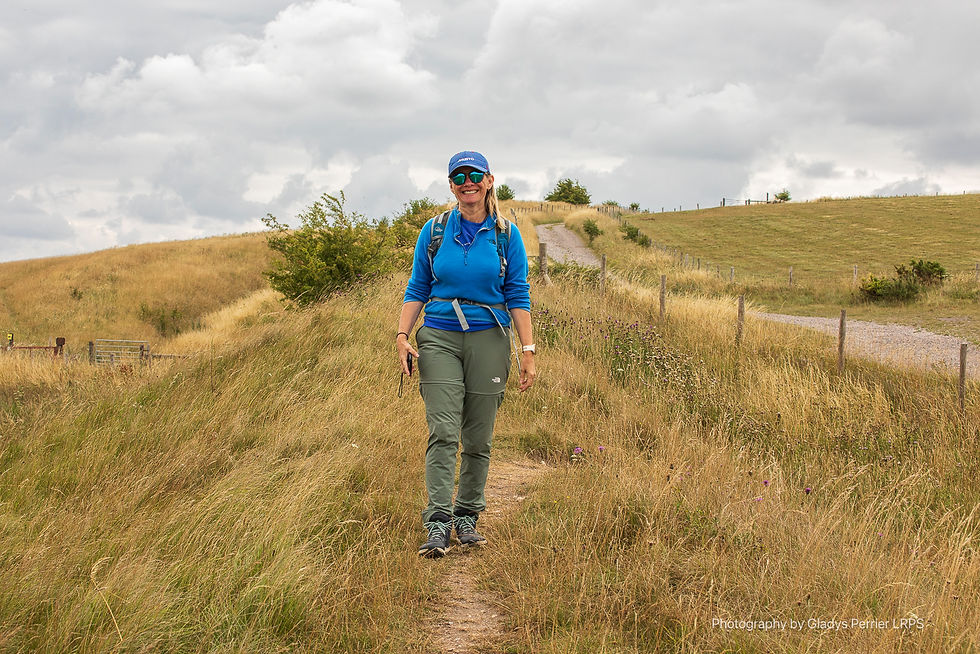
The Wandsdyke is like a wildflower highway. We slowed our pace stopping at every sighting of a butterfly, in awe of the flowing carpet of flowers and sedge either side of the narrow chalk path.

We encountered more cows who came up to the fence, curious. On the other hand, the sheep eyed us suspiciously. A pair were too busy sharing an affectionate moment to budge from their soft, grassy resting place, watching us lazily.


We listened to the sounds of the breeze whispering through the bleached blond sedge and the stridulations of grasshoppers like a string ensemble providing backing to the main performers – the butterflies, creating a soft flutter and the occasional rustle as they clashed wings. Whilst gatekeepers, green veined whites, little skippers, commas and common blues played their part, the peacock butterflies basked on the chalk path again causing us to halt.
In this wide-open rural landscape, there was barely a sign of civilisation until a farm vehicle appeared, dumping a pile of grit along the track, the sound of the insect orchestra interrupted by the tumbling of stones flying out of the trough to the ground.
We had barely walked 3 miles and still we could not pick up the pace with so many sights over which to marvel. Down the sides of the sloping banks swayed sedge, wild carrot and curly dock, the ramparts perfectly framed that iconic Wiltshire feature – the beech clumps on distant barrows.
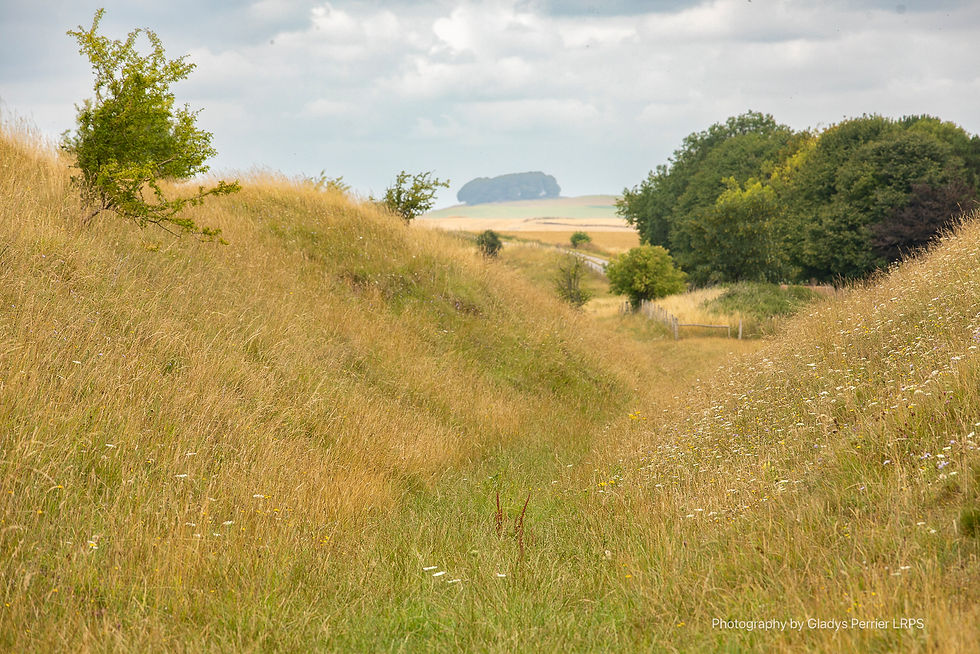
A Butterfly Haven
On the dried seed heads, surrounded by knapweed sat a tiny male common blue butterfly. A small white butterfly probed the scabious for nectar to fuel his flight as did the small skipper and a peacock butterfly. Female common blues gravitated towards the magenta heads of knapweed, where a ringlet and a gatekeeper vied for space. A slightly tattered brown argus favoured the red clover, whilst the ladybirds climbed up and down the lady’s bedstraw. On the path before us red admirals sunned themselves on the chalk. The diurnal dusky sallow moth sat in full sunlight feeding on the knapweed. How could we possibly pick up the pace with so much to see every step of the way.
The haunting cries of the red kite filled the air with its mew-like "weoo-weoo-weoo" and a yellow hammer sang from the highest branches of the hawthorn almost pleading for the ‘cheeseee’ with his little bit of bread.

We rambled on (not a reflection on Michala’s conversation) cutting through the swaths of flowers along the chalk path.
The slopes, like some beautiful delicate embroidery of creamy whites, magenta, yellow, soft mauve and russet created by frilly toadflax, ragwort, round headed rampion, lacey wild carrot, harebells, scabious, clover and knapweed.

Either side of the ramparts we marvelled at the cultivated patchwork of colours with the textured stripes of crops.
Chicory stood out against the golden backdrop on the boundary of gold crops of wheat and barley. Candy stripped bindweed lay low to the ground in a tangle of sedge. Peacock butterflies opened and closed their wings on wild buddleia.
Heading back to Civilisation
Sadly, we had to leave this floral haven and all these heavenly sights and sounds behind as we followed a grit track down towards Bishop’s Canning.

Stretching our imagination, we posed in front of a large tractor housed in the shade of a barn, waiting to take flight like some giant wasp.

A cloud of dust was raised as a farmer whizzed by in her compact utility truck appearing in a great hurry. Encountering her later we realised that she was visiting livestock in different fields to check on them and perhaps leave food.
We saw her again when, searching for a perch for lunch and finding no benches on which to sit, nervous of snakes resting in the shade of fallen logs, we finally found ourselves a resting place on the step of a bridge. There she was in the field behind us checking on not cows or sheep but surprisingly a herd of perhaps 100 goats.
Lunch time Entertainment
As we ate our sandwiches we were greatly entertained by a new sound that filled the air. Every few seconds we heard the expulsion of air as different goats let off wind or sneezed. We approached them, looking over the fence, trying to determine the source of this strange behaviour as this sounded out so frequently. On further investigation I have found out the goats do in fact sneeze as they eat and it is a way of communicating among each other. It was most amusing.
Another interesting fact is that the pupils of a goat are horizontal which increases their line of vision whilst eating, helping them spot predators or strange looking women walking by.
Aspiring to Reach the Spire
We struggled a little with our walking guide which I had picked up in a second handbook shop and the date of publication is torn out so perhaps much has changed since it was written. However, fortunately the tall steeple of St Mary the Virgin at Bishops Canning kept us on track.

This beautiful church is a Grade 1 listed building dating back to the 12th century. We took a short moment inside the church to enjoy the cool and peaceful atmosphere along with the heady smell of lilies.
We continued our way heading through a caravan site with no sign of caravans at all and then we found the canal with narrow boats lining the banks. It was a warm day only just saved by the soft breezing making the heat tolerable. Reed warblers churred among the sighing reeds and boats chugged up and down.
Quirky Felt
We picked up the pace while we followed the obvious path along the Kennet and Avon. On passing one of the boats, I spotted a lady sitting at work under the canopy of her barge. I asked her if she was felting and she confirmed this. She was very happy to show us her crafted articles.
She introduced us to her quirky hares which she is preparing to sell at the Christmas Markets in Bath in a few months time. It makes the thought of braving the heaving crowds at those markets ever so slightly tempting. This lady and her husband retired two years ago and have lived on their boat ever since then. They enjoy the peace and solitude this life brings them, free from stress. The Christmas markets and crowds do not appeal to them either but it is a case of needs must, to create some form of income.
The view of the canal was blocked by a colourful panel of crane’s bill and convolvulus bindweed so we were able to press on without too many distractions.
Local Rock Star
On the outskirts of All Cannings we encountered a lovely beast in bell-bottom trousers, his shaggy mane over his face and blowing in the breeze looking like some aged 1970s rock star. His thick set build contrasted well with the Alton Barnes’ white horse visible on Pewsey Down where we had walked earlier.

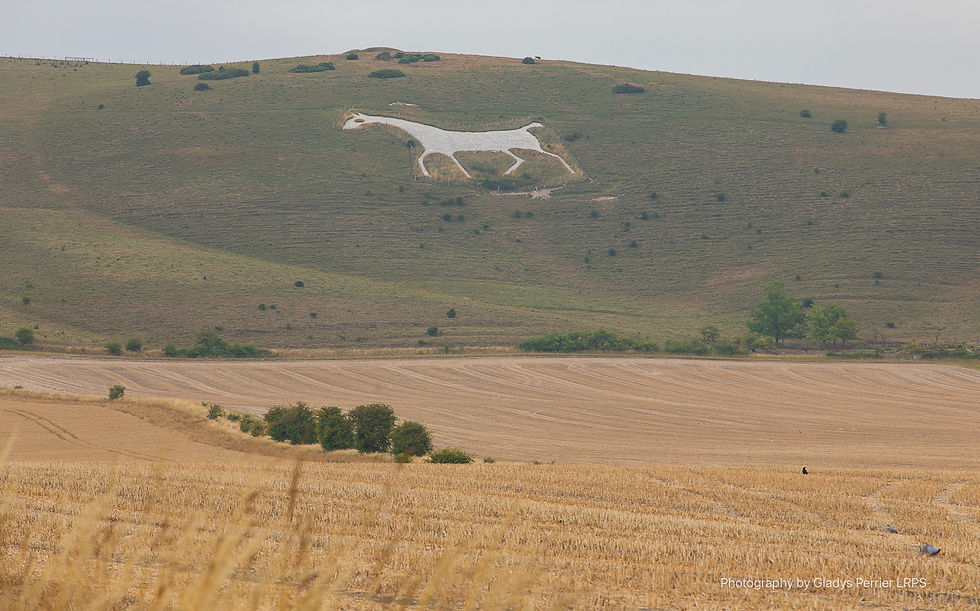
Exhausted by now, we stumbled our way along the side of a field of crops trying to avoid the main road on our final climb back up to our car parked below Knap Hill. The sizzling sound of the fields with grasshoppers singing was interrupted by the churring of a chopper reminding us that life goes on in this rural location. We were walking slower now than the slow worm we saw at our feet.
The Final Challenge
Our final mile was interesting and challenging as we found ourselves searching for a way out of the field and up to our car. Eventually we spotted a stile which took us along a very overgrown path. We debated for a moment about how wise it would be to walk through these tall grasses, where we might pick up ticks. We estimated taking this route we only had a few hundred yards to get back to the car. However, we were truly exhausted and could not face adding any further distance. So, despite the heat, we donned our long-sleeved fleeces to ward off any ticks attaching themselves to our arms. (It is for this reason we always wear long trousers resisting the temptation to wear shorts on a hot day).
We pushed our way through the undergrowth and up a steep chalky path, avoiding trip wires of briars we eventually came out just by the gate leading up to Knap Hill. It was a relief to know we were just a few yards from my car.
Quantum Physics
However, our return to the car was held up at the final moment by two men chatting. We were desperate to remove our boots and collapse into the car but it would have seemed churlish to ignore their friendly faces. One asked me had I seen any strange and beautiful sights to photograph and I responded that yes, I had just found one and I then proceeded to take his photograph for which laughingly he willingly posed.

In return, they engaged us in conversation. One had travelled down from Burton-on-Trent specifically in search of crop circles. The other had travelled from Germany in his campervan in the same pursuit and was bemoaning the fact that whilst he and his wife are here in the UK one of the largest crop circles had been reported in Germany.
They started talking quantum physics, spirituality, conspiracies along and disgruntled farmer however, we politely extracted ourselves explaining we had just walked 14.5 miles and were literally ready to drop.
Thankfully they moved aside and we were able to collapse into the car and head for home marvelling at what an epic journey we had had and making plans to return very soon.

















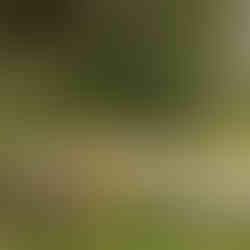

















Experience gaming transparency like never before with KhelRaja's Lottery live draws. We stream high-quality video of every draw directly to your screen, ensuring you witness the integrity of the process as winning numbers are selected. This real-time, immersive feature provides the most authentic and exciting way to play. Our live platform is secure and instantly accessible across all devices, capturing the moment of fortune with absolute clarity. Join KhelRaja and feel the pulse-pounding excitement of a live win!